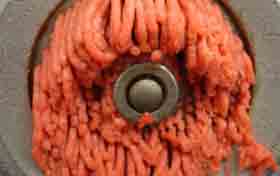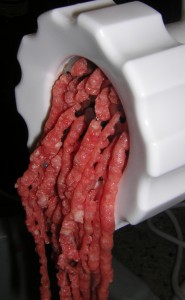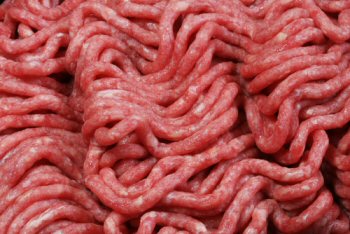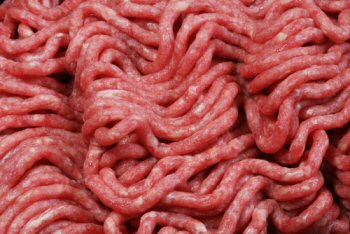The Portland Press Herald ran a two-part series on the Salmonella Typhimurium in ground beef outbreak linked to Hannaford grocery stores in Maine that sickened at least 20 people. Excerpts below:
On the night before Halloween, Danielle Wadsworth’s boyfriend made tacos for dinner at her home in Lewiston. A week later, she was hooked up to two intravenous drips at Central Maine Medical Center as doctors debated whether she needed a blood transfusion.
Wadsworth, an otherwise healthy 31-year-old woman, was one of 20 people known to have been infected with a rare antibiotic-resistant strain of salmonella linked to ground beef sold at Hannaford stores in seven states last fall.
Severe stomach pain and near-constant diarrhea containing blood concerned Wadsworth enough to seek .jpg) medical treatment. She was hospitalized for three days and missed two weeks of work.
medical treatment. She was hospitalized for three days and missed two weeks of work.
"I wouldn’t even wish it on my worst enemy," said Wadsworth, who’s pursuing a claim against Hannaford supermarkets.
Federal and state investigators traced the "genetic fingerprint" of the salmonella to ground beef sold at Hannaford, prompting the Scarborough-based grocery chain to pull 17,000 pounds of meat from its shelves on Dec. 15, 2011, in the first health-related recall of a store-brand product in its 129-year history.
Investigators were never able to identify the source — and possibly prevent more consumers from getting sick — because of Hannaford’s record keeping, even though it exceeded federal requirements. However, Hannaford’s records, like most retailers, still fell short of USDA recommendations.
The first hint at Hannaford that something was wrong came in mid-December, when four investigators from the USDA’s Food Safety and Inspection Service showed up at Hannaford’s South Portland and Schodack, N.Y., distribution centers and a handful of Hannaford stores.
Without telling the company why, they collected copies of inventory records and grinding logs, according to Mike Norton, Hannaford’s director of corporate communications. Hannaford employees were only told it was part of a foodborne illness investigation, one of 17 the agency conducted in 2011.
On the morning of Dec. 15, Norton said, Hannaford’s director of food safety, Larry Kohl, called company executives to a noon meeting at the corporate office on Pleasant Hill Road in Scarborough. Federal food inspectors, working with public health officials, had made a connection between Hannaford’s beef and a salmonella outbreak, he explained at the meeting. They’d hear more later that day, Kohl told the group.
The federal agents told company officials that a national database kept by the CDC had connected 14 people from seven states infected with the same strain of salmonella. Through interviews with the patients, public health officials found that 10 of them had eaten ground beef purchased at Hannaford. (The number of people known to have become sick later rose to 20, with 12 reporting having eaten Hannaford beef in the week before their symptoms appeared.)
Since the USDA doesn’t have the authority to require a recall, it was up to company officials to decide what to do. At that meeting, they decided to recall all store-brand ground beef with a sell-by date of Dec. 17 or earlier — meaning anything that was put on the shelves on Dec. 15 or before.
That set off a chain of events, starting with a message that appeared at 7:45 p.m. on monitors at store registers throughout the chain, telling clerks to alert on-duty managers to immediately check their computers for an important announcement.
Their inboxes contained a list of 10 varieties of ground beef carrying the Hannaford, Taste of Inspirations and Nature’s Place labels that had to be removed from the shelves within an hour.
Meanwhile, the corporate communications staff was putting together a press release that was sent out around 11 p.m. to 675 media outlets and later emailed to 70,000 customers.
The major roadblock in the USDA’s investigation, according to the agency, was the lack of information about ground beef that’s made from "trim," the scraps of meat left over when steaks and roasts are cut in  stores from larger slabs.
stores from larger slabs.
About 20 percent of Hannaford’s ground beef packages are made from trim. The rest comes to the company in tubes of coarsely ground meat that’s ground again in stores and packaged.
Every morning, Hannaford meat clerks grind beef with varying percentages of fat, depending on what’s needed in their store that day. After every grind, they write down information about the meat on a paper log that’s kept near the grinder — fat content, the number of packages made and the sell-by date.
Clerks also write down the lot numbers for each box of tube meat but not the primal cuts whose trim was used for ground beef.
Complicating their ability to trace the source of any tainted beef, the stores didn’t clean equipment between grinding the tube meat and grinding the trim, which created an opportunity for cross-contamination, company officials admit.
The USDA called those practices "high-risk" and pointed to them as the reason its investigation was unsuccessful.
Yet, there are no USDA regulations that require retailers to clean equipment between grinding beef from different companies, or to keep grinding logs at all.
The USDA only requires that meat retailers keep track of what suppliers they use, how much meat they receive and when it arrives.
Still, grocers are aware that the agency recommends a much higher level of transparency, said Daniel Engeljohn, an assistant administrator for the USDA’s Food Safety and Inspection Service.
He said the Hannaford case proves that they’re choosing not to listen.
"We’ve publicly been making statements and developing best practices for retail since at least 2007," Engeljohn said. "It’s evidence that, industry-wide, there has not been good adoption of best practices."
Norton said halting the use of trim was a stopgap measure to simplify Hannaford’s grinding practices and records right away. He said stores resumed grinding trim in the first week of February, but they now clean equipment before and after those grinds and record the source of all cuts of meat used.
Those additional steps have tacked on between one and two hours of work for an employee in every meat department every day, said Norton.
Retailers’ approach to record keeping varies. Some keep detailed records, most don’t. But that could change under a proposed rule that would require retailers to keep detailed grinding logs.
A three-sentence summary of the proposed rule released last month said it would require retailers to record "all source materials" going into ground beef.
Norton said Hannaford hopes the USDA will start holding all meat retailers to that standard and supports the agency’s effort to upgrade record-keeping rules.
At Pat’s Meat Market in Portland, butcher Nick Vacchiano grinds meat every two hours using only trim from cuts of beef sourced from three suppliers in the western United States.
No beef is ground before it gets to the store, and no logs are kept of what goes into the grinder. Vacchiano, whose father owns the Stevens Avenue market, said the operation is so small, there’s no need for extensive records.
"We’re watching everything that goes on," he said.
 procedures so it could better identify the point of origin of its beef and therefore the origin of any contamination.
procedures so it could better identify the point of origin of its beef and therefore the origin of any contamination.
.jpg) Burch Farms.
Burch Farms..jpg) medical treatment. She was hospitalized for three days and missed two weeks of work.
medical treatment. She was hospitalized for three days and missed two weeks of work. stores from larger slabs.
stores from larger slabs. records and procedures at retailer Hannaford.
records and procedures at retailer Hannaford. may be part of this outbreak. Investigators are using data from PulseNet, the national subtyping network made up of state and local public health laboratories and federal food regulatory laboratories that performs molecular surveillance of foodborne infections.
may be part of this outbreak. Investigators are using data from PulseNet, the national subtyping network made up of state and local public health laboratories and federal food regulatory laboratories that performs molecular surveillance of foodborne infections. stores in Maine, New York, New Hampshire and Vermont between Oct. 12 and Nov. 20. No other product description is available at this time.
stores in Maine, New York, New Hampshire and Vermont between Oct. 12 and Nov. 20. No other product description is available at this time.